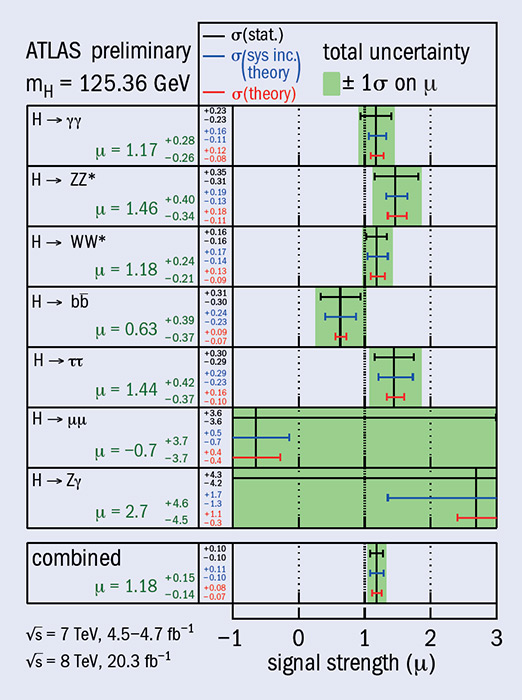
ATLAS physicists are making increasingly precise measurements of the properties of the observed Higgs boson, including production and decay rates, as well as the spin. Comparisons of the results with theoretical predictions could indicate whether new particles or phenomena beyond the Higgs field of the Standard Model are required for electroweak-symmetry breaking.
Recently published studies concern the decays of the Higgs boson into vector bosons (γγ, ZZ, WW, Zγ) and fermions (ττ, bb, μμ) in various production modes (ATLAS Collaboration 2015a). Measurements of the signal strength, μ = σ/σSM, allow the measured cross-sections, σ, of each decay channel to be compared to that predicted by the Standard Model, σSM. The figure shows that the results are compatible with the Standard Model’s prediction, that is, μ = 1. The new combination of all of the production and decay channels gives the most precise value from ATLAS to date: μ = 1.18 + 0.15 – 0.14.
Other new results include studies of the rare process of Higgs-boson production in association with two top quarks – a channel that allows physicists to probe directly the mysteriously large top–Higgs Yukawa coupling (ATLAS Collaboration 2015b). The analyses looked at a number of different decay modes of the Higgs boson, including decays into fermions (bb, ττ), and into bosons (WW, ZZ), the latter mode being measured for the first time by ATLAS in association with top quarks. Gathering all of the decay channels together, the data show a small excess of events over background with a strength μ(ttH) = 1.8±0.8. This gives a significance of 2.4σ with respect to a “no ttH” hypothesis. Observation of the Higgs boson in this production mode will require the new data expected in the LHC’s Run 2.
The LHC will soon restart running with a proton–proton collision energy of 13 TeV, more than 60% higher than that of Run 1
ATLAS has also improved its studies of the spin and parity of the Higgs boson (ATLAS Collaboration 2015c). The Standard Model hypothesis of a spin-0 particle with positive parity is favoured at more than 99% confidence level.
In addition, the ATLAS and CMS collaborations have joined forces to combine their precision measurements of the mass of the Higgs boson, and recently presented a new combined value of mH = 125.09±0.24 (0.21 stat.±0.11 syst.) GeV, with an uncertainty reduced to two parts in a thousand (0.2%).
The LHC will soon restart running with a proton–proton collision energy of 13 TeV, more than 60% higher than that of Run 1. The production rate of the Standard Model Higgs boson will increase by more than a factor of two, and that of the rare ttH process by almost a factor of four. ATLAS is ready to exploit the full potential of Run 2 to study the Higgs boson and to look beyond for new phenomena.
Further reading
ATLAS Collaboration 2015a ATLAS-CONF-2015-007.
ATLAS Collaboration 2015b ATLAS-CONF-2015-006, arXiv:1503.05066 [hep-ex].
ATLAS Collaboration 2015c ATLAS-CONF-2015-008.





